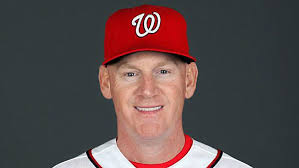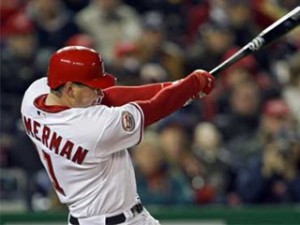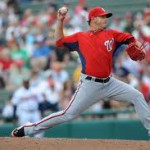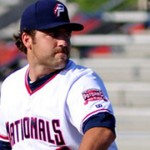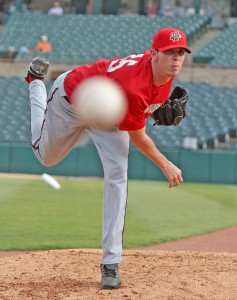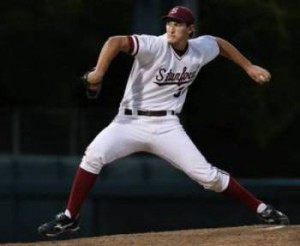
The Nats liked Mooneyham a lot more than pundits did. How did he do in his first pro season? Photo via mlbdraftcountdown.wordpress.com
John Sickels writes the very good blog located at www.minorleagueball.com. He does profiles on Minor League players, reviews the day’s marquee Minor League games, and generally does a good job highlighting the guys down on the farm.
Late this past season he embarked on a project where he has reviewed the performance of EVERY draft pick, by round, from the 2012 draft. This, as you might imagine, is one heck of an effort. In fact, in one of his later posts, he admitted he may not have the sanity to continue this all the way through all 40 rounds of players. In fact, he didn’t; he made it through 17 rounds and last posted on this thread 9/27/12. So I’ve completed his quick-hit analysis/statistical summary for the rest of our picks who debuted this year.
Below is a cutting-n-pasting of Sickels’ round-by-round analysis of the Nats players taken. I’ve put in links in the form of the “Round N” at each spot so you could read his original post. The (YY) number is overall draft pick positioning. Lastly, he started this series in mid-August, so I’ve updated the first several playerswriteups from Sickels’ to have season-ending stats, but his blurb is usually still accurate enough. After round 17, I’ve filled in the details in Sickel’s style for the rest of our draftees.
(For draft reference, click here for the fantastic Nationals Drafttrack Google XLS, created by Brian Oliver and now maintained by “SpringfieldFan.” Also, for 2012 draftee information, thanks to Sean Hogan‘s 2012 Nats draft pick blog research, which I’ve quoted at various places here. He has the best available summary of each draftee’s information.
Round 1: (#16 overall) Lucas Giolito, RHP, Washington Nationals: Threw two innings in the Gulf Coast League on August 14th. [Editors Note: obviously we all know by now that those two innings resulted in Giolito’s blowing the partially torn UCL, and he has subsequently had Tommy John surgery. My thoughts on the pick and the resulting surgery have been published here before].
Round 2: (80) Tony Renda, 2B, Washington Nationals: .264/.341/.295 with 31 walks, 33 strikeouts, 15-for-18 in steals over 295 at-bats for Auburn in the NY-P. Controlling zone well, steady glove, but lack of pop is disappointing. He did improve his average 30 points in the last few weeks of the season, finishing hot.
Round 3: (111) Brett Mooneyham, LHP, Washington Nationals: 2.55 ERA with 29/16 K/BB in 42 1/3 innings for Auburn in the NY-P, 36 hits. Just like in college: looks like a pitcher, good arm, but doesn’t dominate the way you think he should. Like Renda, a couple of good late outings improved his peripherals.
Round 4: (144) Brandon Miller, OF, Washington Nationals: .292/.354/.549 with four homers, 10 walks, 36 strikeouts in 113 at-bats for Auburn in the NY-P. Small sample, but fits the scouting reports perfectly: he’s got a ton of power, but struggles for contact.
Round 5: (174) Spencer Kieboom, C, Washington Nationals: .258/.362/.305 with 19 walks, 24 strikeouts in 128 at-bats for Auburn in the NY-P. Has thrown out 44% of runners, but bat looks doubtful.
Round 6: (204) Hayden Jennings, OF, Washington Nationals: .192/.254/.231 with 11 walks, 70 strikeouts in 156 at-bats in the GCL. Has stolen 17 bases in 19 attempts, but his strikeout rate is obscene.
Round 7: (234) Robert Benincasa, RHP, Washington Nationals: 3.09 ERA with 32/3 K/BB in 23 1/3 innings for Auburn in the NY-P, 27 hits, 2.00 GO/AO. Slot bonus from college, could move quickly as reliever if healthy, just went on DL [Editor’s note: the DL trip seemed innocuous, a roster manipulation at season’s end].
Round 8: (264) Stephen Perez, SS, Washington Nationals: Below slot bonus for college infielder, awful hitter so far, .222/.252/.364 with four walks, 40 strikeouts in 99 at-bats between GCL and NY-P. Glovework also disappointing. Has good tools but didn’t play up to expectations in college at Miami, and hasn’t in pro ball so far either.
Round 9: (294) Derek Self, RHP, Washington Nationals: Below slot college pitcher, solid in pro ball so far, 3.27 ERA with 25/8 K/BB in 33 innings for Auburn in the NY-P, 32 hits, 14 saves. Good fastball/cutter combination.
Round 10: (324) Craig Manuel, C, Washington Nationals: College backstop with good defensive and intangible rep, bat questions kept him to a small bonus. So far, hitting .287/.376/.315 with 16 walks, 11 strikeouts in 143 at-bats for Auburn in the NY-P, with 41% of runners caught. If he had any power at all, he’d be a major sleeper.
Round 11: (354) Brian Rauh, RHP, Washington Nationals: Slot bonus for college pitcher, 3.99 ERA with 43/26 K/BB in 59 innings for Auburn in the NY-P and Hagerstown in the Low-A South Atlantic League. Held his own in pro ball although component ratios aren’t great.
Round 12: (384) Carlos Lopez, 1B, Washington Nationals: Below slot bonus college first baseman, solid slugger at Wake Forest but didn’t repeat success as a pro, .253/.332/.376 with three homers, 20 walks, 50 strikeouts in 170 at-bats for Auburn in the NY-P. Age 22.
Round 13: (414) Elliott Waterman, LHP, Washington Nationals: Slot bonus college pitcher from San Francisco, 4.97 ERA with 24/22 K/BB in 25 innings for Auburn in the NY-P, 31 hits. Held back by control issues at this point. Age 21.
Round 14: (444) Jordan Poole, OF, Washington Nationals: Another junior college guy, this one from Florida, name was called as a pitcher but he played outfield in pro ball, hit .205/.264/.295 with 10 walks, 58 strikeouts in 132 at-bats between GCL and NY-P. That won’t get it done.
Round 15: (474) Brandon Smith, OF, Washington Nationals: California prep didn’t sign, honored committment to Grand Canyon University.
Round 16: (504) Ronald Pena, RHP, Washington Nationals: Junior college pitcher from Florida, low 90s stuff, 6-4, 195 build, 12 innings with a 2.92 ERA and a 9/1 K/BB, five hits allowed between GCL and NY-P. Sleeper potential.
Round 17: (534) Blake Schwartz, RHP, Washington Nationals: College senior from Oklahoma City University, originally from Minnesota, performed well in pro debut with 3.05 ERA, 41/11 K/BB in 38 innings, 39 hits in the South Atlantic League. Considered a sleeper by some Midwestern scouts due to his command.
Round 18: (564) David Fischer, RHP, Washington Nationals: College senior from U-Conn, the lanky right handed hurler (6’5″, 175lb) struggled in his Short-A debut, posting a 4.96 ERA, 31/14 K/BB in 49 innings, 56 hits. Fischer only had a GO/AO ratio of 1.11, so he needs to work on keeping the ball on the ground in 2013. Considered a possible top-10 talent early in the 2012 college season, Fischer’s fastball sits 92-93 on a projectionable frame, but his off-speed pitches need work.
Round 19: (594) Brian Lippincott, 1B, Washington Nationals: a College senior from Concordia, this left-handed batting first baseman hit .281/.361/.374 with 16 walks, 29 strikeouts in 139 GCL at-bats. This is decent but far less impressive than Lippincott’s college career, where he hit .494 his senior season to led all Division II batters. He showed some power in college but relatively little in pro-ball; he’ll need to feature more power to stick at first base.
Round 20: (624) James Brooks, SS, Washington Nationals: a College senior from Utah hit .273/.345/.354 with 8 walks, 25 strikeouts in 99 GCL at-bats. He was 1-32 in 10 games in Auburn before being dropped down to the Rookie League. Perhaps the most interesting thing about Brooks is his birth place: Melbourne, Australia. No word yet whether he’s under consideration for Australia’s 2013 WBC team.
Round 21: (654) Austin Chubb, C, Washington Nationals: College senior from Florida Southern hit .209/.260/.373 with 3 walks, 11 strikeouts in 67 GCL at-bats. He hit left-handers to the tune of .400, but in a catcher-platoon, only catching every third day or so, he struggled to get going in 2013. He only threw out 3 of 12 runners and allowed 2 passed balls in his 10 games behind the plate. He’ll have to improve all around in 2013.
Round 22: (684) Will Hudgins, RHP, Washington Nationals: a College senior from Notre Dame (who hails from Richmond, so he has local roots) posted a 2.22 ERA, 31/6 K/BB in 44 2/3 innings, 41 hits split between GCL and AUB. Decent numbers despite being a 22-yr old in rookie ball, he has some promise as he fills out and moves forward. Perfect Game only has him with a mid-80s fastball but “with life;” I’m hoping that’s an old reading.
Round 23: (714) Casey Selsor, OF/LHP, Washington Nationals: this College Senior from UT-San Antonio was drafted ostensibly as an outfielder but threw 41 innings in rookie-ball while also getting a handful of at-bats/games in the field. He did neither relatively well; posting a 6.10 ERA, 34/15 k/bb in those 41 innings giving up 50 hits and seven home runs. While playing the out-field he was 1-6 in 3 games, hardly a judge-worthy sample size. The Nats clearly like this guy, having drafted him in 2008 out of high-school, so count on him sticking around at least a couple years. On the mound, he features as an undersized lefty (he’s only 5’10”) who throws upper 80s but with excellent secondary stuff.
Round 24: (744) Kevin Dicharry, RHP, Washington Nationals: College Senior from University of Texas missed most of his college career with shoulder issues (tendinitis) after an excellent freshman year. His pro debut looked very promising; 2.84 ERA, 22/4 K/BB in 25 1/3 innings, 19 hits, zero homers allowed. Dicharry was highly regarded nationally graduating high school (a 2nd team Rawlings All-American and a marquee part of Texas’ recruiting class) and this pick represents a great value pick for the Nats if Dicharry regains some of his past form. He reportedly is showing a low 90s fastball, a tight curve and a good change this year, to go with his excellent control (nearly a 6-1 k/bb ratio). A sleeper prospect if he stays healthy.
Round 25: (774) Freddy Avis, RHP, Washington Nationals: California prep didn’t sign, honored commitment to Stanford.
Round 26: (804) Skye Bolt, RHP, Washington Nationals: Georgia prep didn’t sign, honored commitment to UNC.
Round 27: (834) Cody Poteet, RHP, Washington Nationals: California prep didn’t sign, honored commitment to UCLA.
Round 28: (864) Hunter Bailey, SS, Washington Nationals: College senior from Oklahoma State hit .247/.345/.329 with 8 walks, 12 strikeouts in 73 GCL at-bats. He clearly features as a low-power middle infielder glove and may struggle to stand out in the system.
Round 29: (894) Leonard Hollins, RHP, Washington Nationals: A JuCo 2-year graduate from Chipola college threw 9 no-hit innings in the GCL and then was jumped to low-A, where he posted a 4.50 ERA in 18 innings, 8/7 K/BB ratio, giving up 18 hits. He’s a submarining right-handed reliever who had a tendency to pitch either a perfect 1-2-3 inning or give up a slew of hits. He’s tough to get the ball in the air on though; a 3.50 GO/AO ratio in Hagerstown and zero homers given up in 27 IP in his pro debut across both levels. He could be an intriguing, difficult-to-scout/hard to quantify reliever for the team moving forward. A sleeper reliever prospect.
Round 30: (924) Robert Orlan, LHP, Washington Nationals: A junior draftee out of UNC, Orlan suffered an elbow injury late in the college season and was immediately placed on the 60-day DL by the team. No bonus information is given for the player, who likely signed with the team knowing that a year’s recovery from Tommy John would have cost him his entire senior year of college too. He profiled as a top-15 round talent, a lefty with decent velocity (upper 80s coming out of HS, presumably more now) and a decent variety of pitches. Another value pick by the Nats, who could get a later-round steal if Orlan regains some of his promise after injury recovery.
Round 31: (954) Michael Boyden, RHP, Washington Nationals: This college senior out of University of Maryland quickly was promoted out of the GCL and posted a 1.44 ERA in 25 innings of short-A. His control was pretty bad though: 22/17 K/BB ratio in those 25 innings. In college he reportedly showed 90-92 with flashes to 94, but dropped because of his size and control issues. This local product (he grew up in La Plata, played a year at GW and finished at Maryland) likely gets lucky to be drafted by his local team, and we’ll see if his wildness causes some regression on these numbers in the future.
Round 32: (984) Michael Mudron, LHP, Washington Nationals: College senior from Cal State San Bernadino posted a 3.75ERA in 24 innings in the GCL, with a 27/8 K/BB ratio, 16 hits. A decent K/bb ratio, decent numbers for Mudron (who is incorrectly listed on milb.com as a right-handed pitcher). I cannot find any scouting information, but assume that he profiles as a lefty match up guy (though his 2012 splits showed little lefty-lefty matchup capability).
Round 33: (1014) Mike McQuillan, 2B, Washington Nationals: College senior from Iowa hit .268/.362/.430 in 149 ABs for Auburn after being promoted out of the GCL. 21 walks and 27 Ks in those 149 Abs. He features as a classic undersize 2nd baseman with little pop, but if his OBP stays above .350 he should continue to rise in the system.
Round 34: Jake Jeffries, 2B: California Prep did not sign, honored commitment to Cal St. Fullerton.
Round 35: Corey Bafidis, LHP: Texas Weslylan junior opted to return for his senior season.
Round 36: Max Ungar, C: Maryland Prep did not sign, honored commitment to Denison.
Round 37: Tyler Watson, LHP: Texas Prep did not sign, honored commitment to Kansas.
Round 38: Jarred Messer, RHP: Mallone College (OH) junior opted to return for his senior season.
Round 39: Mitchell Williams, C: Georga Prep did not sign, honored commitment to the Marion Institute.
Round 40: Ricky Gutierrez, CF: Florida Prep did not sign, honored his football commitment to U-Conn.
There you have it; your 2012 draft class. So far, there seems like there’s some definite sleeper potential in the lower rounds and some players who played above their draft position. I can’t wait to see how the likes of arms Pena, Schwartz, Hudgins, Dicharry and eventually Orlan pan out.
